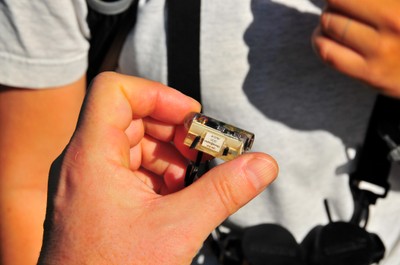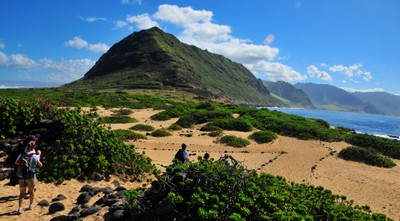Today we hiked out to Ka’ena Point, at the western tip of the island of Oahu, to visit the Ka’ena Point Natural Area Reserve.

Ka’ena Point is a wild and beautiful place, home to a small colony of Laysan albatross – the only colony on Oahu. We walked along an old railroad track not far from where Lostis filmed, with mountains on one side and the beautiful, blue North Pacific on the other side. Ka’ena Point came as a welcome contrast to the bustle of urban Honolulu and Waikiki, which we surveyed yesterday from Diamond Head.
Our guide today was Lindsay Young, a conservation biologist at the University of Hawaii, who is studying the dynamics of the albatross colony. One of her most intriguing findings is that a third of the breeding pairs at Ka’ena Point are comprised of two females – the females co-operate to incubate and raise a single chick, just like male-female pairs. Lindsay attributes this behavior (which she refers to as chicks raising chicks) to a skewed sex ratio in the colony – males are in short supply, so female birds mate with males and then pitch in to raise their young with another female. We saw several such nests today – each with a female incubating her egg, waiting for her partner to return and take her place.

We helped Lindsay to survey the colony and to capture one bird to recover a geo-location tag (which records the travel and behavior of the birds at sea) and two others for blood sampling (one of which was a recent immigrant from Midway Atoll). The birds seemed slightly indignant of this intrusion, but soon resumed their normal behavior, clucking at us in a slightly reproachful manner.

Ka’ena Point is the site of an inspiring ecosystem restoration project, in which Lindsay and her colleagues are removing invasive plants and replacing them with native species. Later this summer a fence will be constructed to protect the breeding sea birds by preventing the entry of mammalian predators (dogs, feral cats, mongoose and rats). Ka’ena Point has special significance to native Hawaiians, because it is the place where human spirits leave Oahu, so the planners of the restoration project have taken great care to make sure that the cultural needs of Hawaiians are integrated into the project.

Tracy Wurth, the Main Hawaiian Island Monk Seal Coordinator from NOAA’s Pacific Islands Fisheries Science Center also accompanied us to Ka’ena Point. Most of these highly endangered seals are found in the Northwestern Hawaiian Islands, although there is a small and growing population in the Main Hawaiian Islands. We saw a single monk seal hauled out at the very tip of Ka’ena Point – Tracy identified it as Benny, a young seal born on Kaui several years ago.
As we walked back from the Point we watched humpback whales blowing and flipper-slapping just outside the surf. We returned to our big, white van tired, hot, excited about our experiences and full of optimism for the future of the albatrosses and the ecosystem at Ka’ena Point.

how cool, thanks for posting.
That just looks amazing, and you are doing a great job! Keep up the good work, and keep up posting.